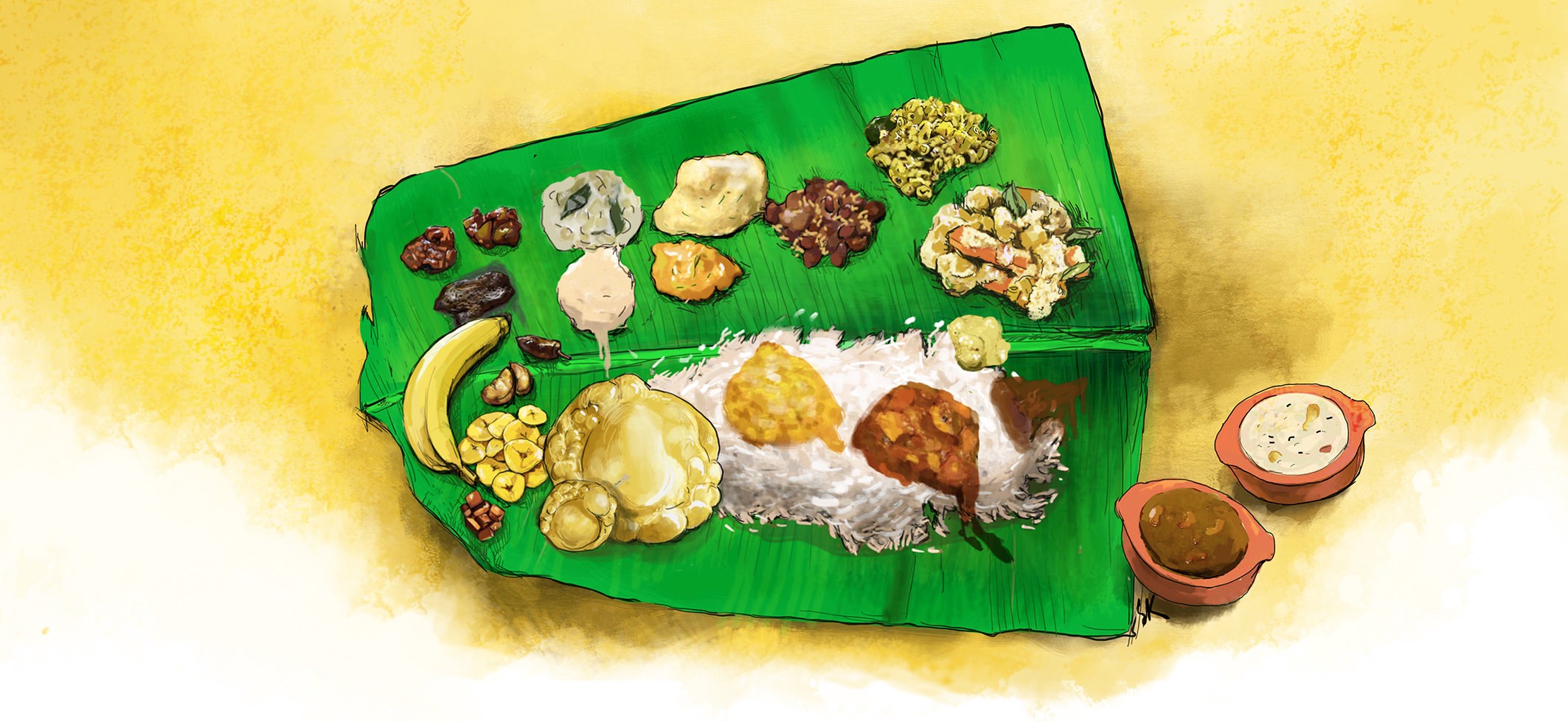
By Ramya Menon
Illustrations by Sajeev Kumarapuram
 he pitter patter of a shyly receding monsoon, greeted me as I stepped out from the airport. Loud hoardings screamed the divinity of the state of Kerala, my homeland. Everywhere I looked people were scrambling about in distracted joy, for it was party time in the toddy loving, communism touting Indian state; it was time for Onam.
he pitter patter of a shyly receding monsoon, greeted me as I stepped out from the airport. Loud hoardings screamed the divinity of the state of Kerala, my homeland. Everywhere I looked people were scrambling about in distracted joy, for it was party time in the toddy loving, communism touting Indian state; it was time for Onam.
As a non-resident Indian child growing up in Kuwait, the highpoint of the year was going to my parents’ ancestral homes in Kerala, and being surrounded by the green landscapes and the boisterous energy that is so typical of this state.
Now, when I return from England as an adult, I am engulfed by a feeling of profound nostalgia and can’t wait to explore the secrets of my motherland once again.
In the past, luck was my friend. The searing summer heat of the Middle East happily coincided with festival season in Kerala. The bonhomie that captures the very soul of Kerala as Onam descends cannot be described. Markets burst from all corners selling everything from fried goodies to plastic jewelry and empty streets get filled with the entire population trying to steal a deal.
It so happened that my return to Kerala this time happened when Onam was lurking just around the corner, waiting to engulf me in all its charm.
What is Onam?
Onam is Kerala’s biggest festival. Of course, like anything else in India, this is steeped in legend.
The story, as I have heard from a geriatric uncle, goes something like this.
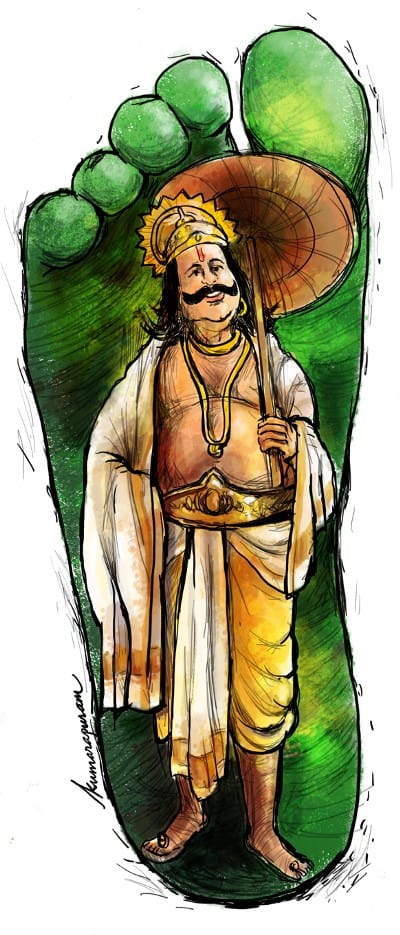
The erstwhile demon king of Kerala, Mahabali (don’t let the demon bit scare you, he was a god-fearing happy-go-lucky fellow by all accounts), was a tad arrogant of his own benevolence.
The good king was also mighty. So the king of gods, Indra, fearing a power struggle sent, Lord Vishnu, to deal with the issue.
This time, Vishnu took the form of a dwarf aka Vamana.
Mahabali affectionately called Maveli was conducting a great sacrifice when Vamana came there seeking alms.
As expected Maveli asked Vamana what he wanted. Seizing his opportunity, the little trickster then requested three paces of land.
When the king agreed, Vamana or rather Vishnu grew in size to his full stature. With his first stride, he covered the entire skies, and in the second he covered the netherworld. Realizing that the only other piece of land left was the earth, Mahabali graciously offered himself. Vamana then pushed the king into the netherworld, never to threaten the Gods reigning above.
But because of his sincerity, and the fact that he was actually a great man, Lord Vishnu, bestowed on him the gift of returning to the land once a year and looking upon his subjects, and generally having a gala time.
So, once a year, all the Malayalees get dressed to the nines, decorate their house with artistic floral displays (pookkalams) and prepare the feast of a lifetime in honour of the visiting king, so that he can see all his subjects are blooming and prosperous.
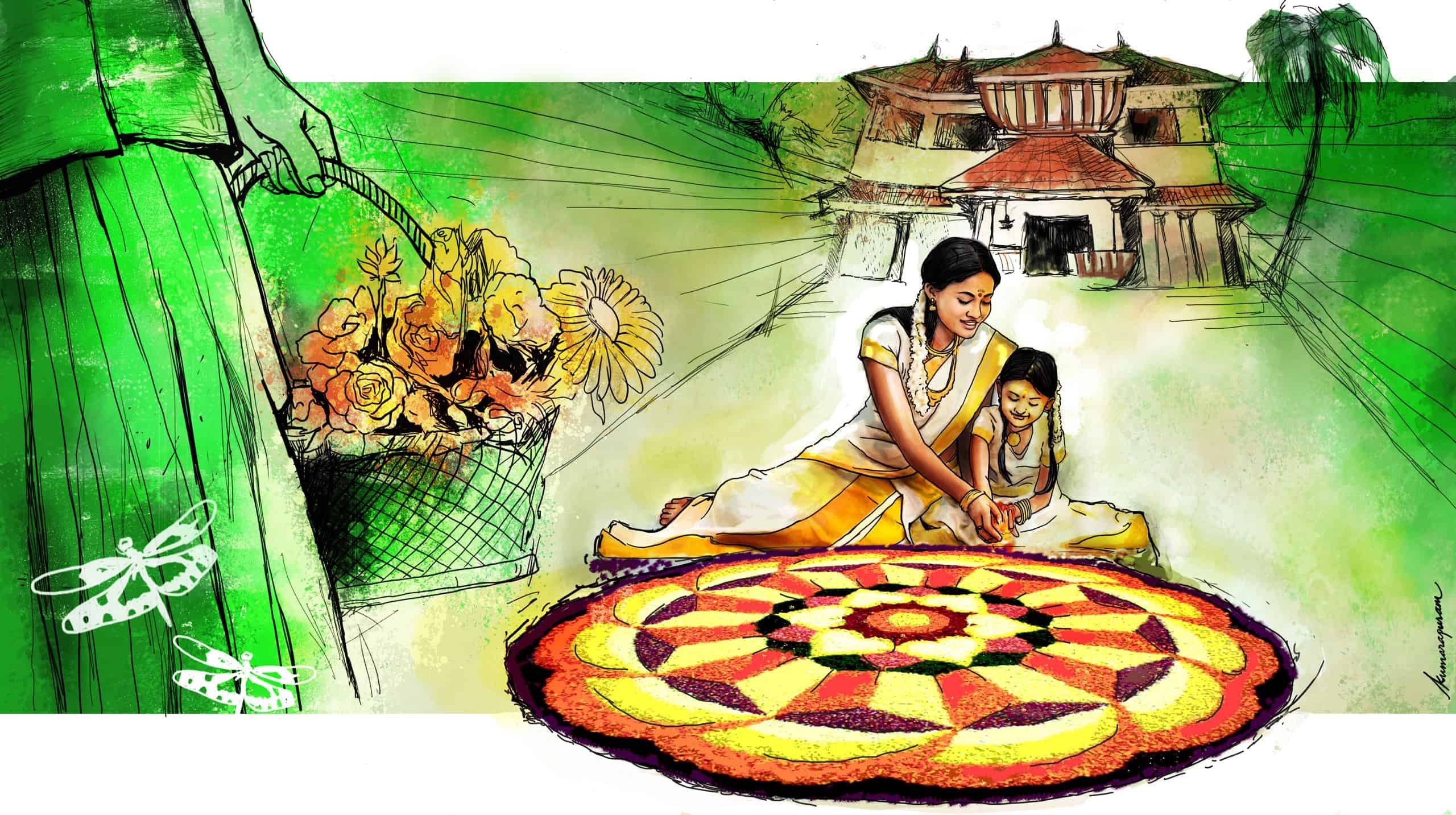
But it’s not just legend that gives the coconut loving Malayalee a reason to celebrate, Onam is also that time of the year when the months of slogging with sickle and soil results in a prosperous produce. It is a harvest festival signalling the end of the riotous monsoons and the commencement of a time of plenty.
For the curious cats who can’t wait to find out all about Onam, click here.
Thank god for elastic stomachs!
The one thing that I looked forward to every holiday, after an almost regular diet of store bought pita bread and meat, was the tantalising vegetarian delicacies that my grandmas’ churned out on this momentous occasion. The Onam Sadya is literally a treat for sore eyes and a gastronomical blitzkrieg of chaotically complimentary flavours.
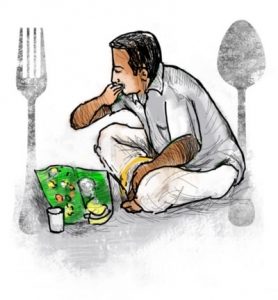 Now the Onam Sadya is an art form in itself. There is so much detail, precision and science that goes in to the preparation of this gargantuan spread. It is almost like a play, with every dish playing a central part in creating a great drama of sorts that crescendos into a scintillating climax. I decided to also get some research going on the subtle nuances and processes that made the Sadya more than just an elaborate lunch.
Now the Onam Sadya is an art form in itself. There is so much detail, precision and science that goes in to the preparation of this gargantuan spread. It is almost like a play, with every dish playing a central part in creating a great drama of sorts that crescendos into a scintillating climax. I decided to also get some research going on the subtle nuances and processes that made the Sadya more than just an elaborate lunch.
So I approached the self made king of the Sadya in Kochi, Anandaraman from Vinayaka, the most sought after name in the catering and wedding business in the city, and sought his guidance in understanding the art of plating. Its not enough to cook this meal, the order and form in which it is served is equally important. I have also understood from several sources at the Guruvayoor Devasom, (Guruvayoor is like the Vatican of the Malayalee Hindu, a tourist’s delight and a religious haven) where a Sadya is churned out on a daily basis, that the reason for this particular way of serving, has to do with maintaining the temperature of each dish. While it is alright for the pickles to be cold, it would be criminal to serve Sambhar, the mixed vegetable soup, that was anything but piping hot!
Did you know that some Sadyas, had as many as 65 dishes! All the rich gentry used Onam as an occasion to awaken jealousy amongst peers by putting on larger than life displays of their wealth on the banana leaf. Imagine the size of that leaf!
Since I have managed to find a firm footing in the kitchen, this year I decided to go ahead and make one of these grand feasts myself. Ambitious, I know, for a typical Sadya has about 30 dishes to be prepped and plated on the green as grass banana leaf or ‘ela’.
And my mini attempt at something resembling a Sadya, was well appreciated by my pot roast loving, carnivorous English friends. So all the more incentive to test the waters on the homeland.
Say hello to the chief characters on the Banana Leaf
 ow let me preface this by saying that I cannot for the life of me find the suitable translations for some of these dishes, but I’m going to try my level best nonetheless. And for those of you who are a little worried about the idea of eating from a leaf, worry not, for the Sadya tastes just as good on a plate. But for the adventurous, many Indian stores in England ( read East Ham) , the United States and the Middle East, do have a supply of Banana leaves flown in specially for the occasion.
ow let me preface this by saying that I cannot for the life of me find the suitable translations for some of these dishes, but I’m going to try my level best nonetheless. And for those of you who are a little worried about the idea of eating from a leaf, worry not, for the Sadya tastes just as good on a plate. But for the adventurous, many Indian stores in England ( read East Ham) , the United States and the Middle East, do have a supply of Banana leaves flown in specially for the occasion.
And as I mentioned before, the art of laying out the leaf, is a beautiful process that has been passed down through the generations. So check out how this is done on the video given further below.
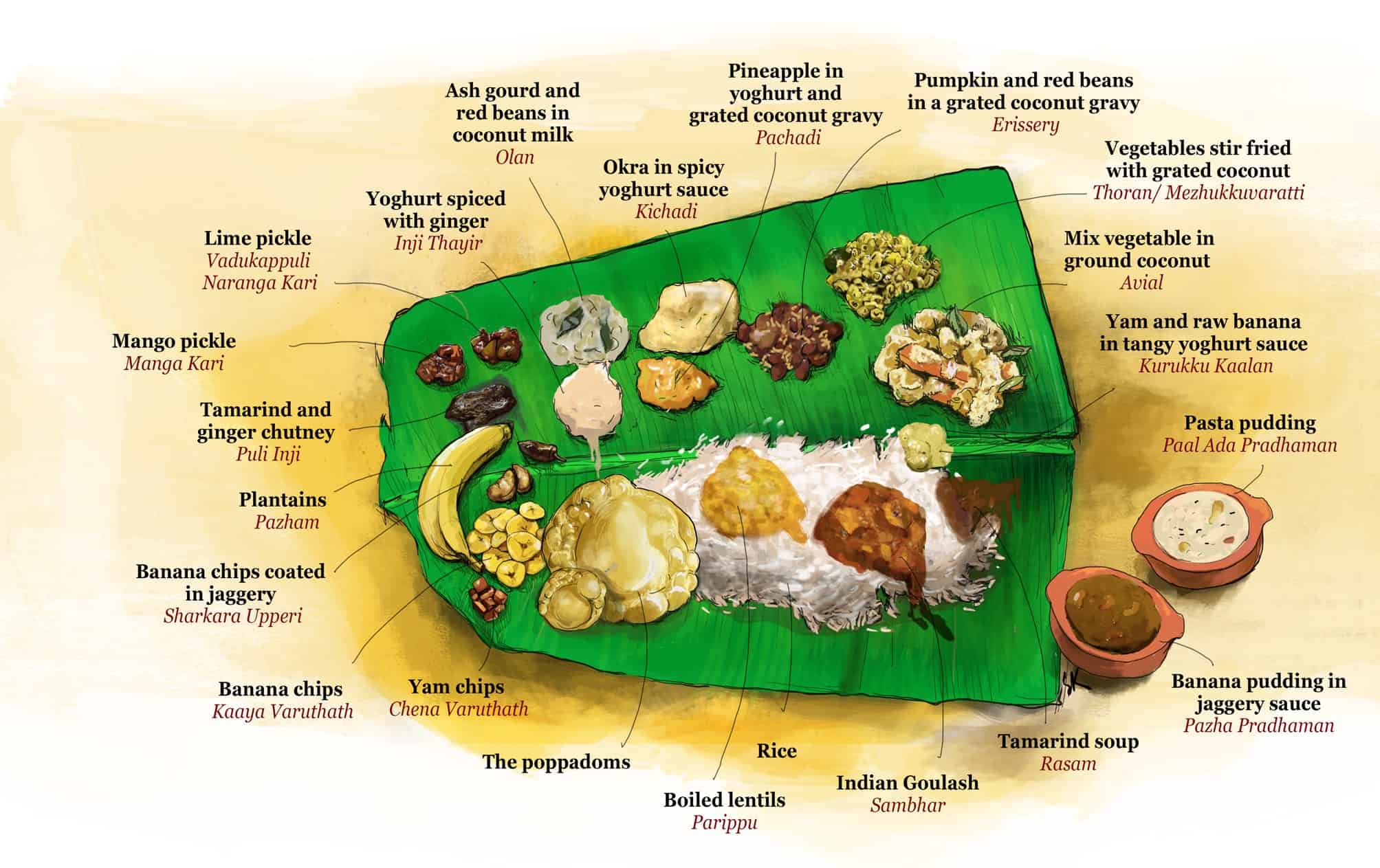
The Pickles (Uppil Ittath) aka the Palette revitalisers : These are the first to make an appearance on what will soon be an impressive array of dishes. They are served on the bottom left corner of the leaf, as shown in video.
Click on the dish and find the recipe with some easy peasy steps. Yes, it is that simple
1. Tamarind and Ginger Chutney (Puli Inji)
2. Mango Pickle (Manga Kari) not to be confused with Pathaks Mango Chutney that you find in Walmart and Tesco
3. Lime Pickle (Vadukappuli Naranga Kari)
4. Yoghurt spiced with ginger (Inji Thayir)
The Fried Goodies aka Upperis: Just above the pickles rest these deep fried crisps. But oh, they are not made of potato, and one is even sweet. Can it get better than this!
5. Banana Chips (Kaaya Varuthath)
6. Banana Chips coated in jaggery (Sharkara Upperi)
7. Yam chips (Chena Varuthath)
8. Plantains
Can we do culinary without Curry?
Now comes the array of ‘koottans’ or curries , although this will be nothing like a chicken jalfrezi or a lamb korma, and definitely not like the pathetic frozen variety that we poor sods had to live on in University. These are spread through the leaf as shown.
9. Okra in spicy yoghurt sauce (Kichadi): Made usually with okra or bitter gourd, this is one of those dishes that are fast disappearing from several leaves across the state. Pity, really!
10. Pineapple in yoghurt and grated coconut gravy (Pachadi): The pineapple is not something that is native to Kerala, but its fibrous quality and its obvious potential, resulted in the creation of the pineapple pachadi. Now a little secret for the ladies out there, this helps regulate those pesky cycles too. Win win, I say!
11. Now this is one of those difficult to translate ones. Pumpkin and red beans in a grated coconut gravy, maybe? or the Erissery: Now no story of the Onam Sadya is complete without a special mention to this little treat. It is said that the powerful aromas, that emanate from the tempering of mustard seeds and curry leaves in fresh coconut oil, is what draws Onam’s mascot, Maveli into our midst. Though, I have now been told conspiratorially by the Swamy that it was just an old wives tale intended to make sure that the tempering was just right.
12. Ash gourd and red beans in coconut milk (Olan): They say if the Sambhar is the king, then the Olan is the minster; and I don’t disagree.
13. Mix vegetable in ground coconut (Avial): This is one of the Mommy favourites. There are soo many nutrients packed in to this puncher that, this alone will take care of most of your vitamin requirements.
14. Potato stewed in coconut milk (Istu) : Of course, that’s not how we Malayalees, refer to it. If you come to Kerala and ask for a stew, you may be confronted with a rather vague look, call it, ‘istu’ and you will be served ladlefuls of the mild but flavourful curry.
15. Vegetables stir fried with grated coconut (Thoran/ Mezhukkuvaratti): Simply put a stir fry with freshly grated coconut. Now there are as many types of Thorans as there are vegetables. They can come in all sorts of colours and combinations. Quite versatile.
And here is a video of the arrangement on the leaf.
Above the Kichadi and Pachadi, but served after all these items have already been laid out is the Kurukku Kaalan. Many a households guard the secrets of this tangy, delight like they would their valuable heirlooms, fiercely contesting the uniqueness of each recipe in an almost childish manner, for that is how awesome, this dish is, if made right.
16. Yam and raw banana in tangy yoghurt sauce (Kurukku Kaalan)
The poppadoms: Now this is placed just above the upperis n pickles
17: Big Poppadom
18: Small Poppadom
Nowadays the practise of placing these two varieties of poppadoms have given way to two medium sized poppadoms. Well, all that hypertension and coronary heart disease needs to be thought of, I suppose. Apparently, the money bags from the community tried to upstage each other with the size of their poppadoms, some the size of actual plates.
19. Boiled Lentils (Parippu) : The dal is served with a generous helping of ghee which represents prosperity and wealth. The more liberal the server is with the ghee, the more affluent the master of the house is.
20. Rice: Even the rice is different, it’s not the white basmati that India is famous for. This is brown, par boiled and not very aromatic. But then again, what it lacks in aroma, it makes up for with its stomach friendly qualities, its digested way faster than white rice.
21. Indian Goulash (Sambhar) : The sambhar is the first dish to make a reappearance, because apparently at least 50% of the consuming public would want a second helping.
22. Tamarind soup (Rasam): By the time this delicate, watery, soup is served, ideally the ela should be cleared of all the other curries, to make way for the final few specialities.
The Dessert, Pradhamans: Now this is a fiercely contested battle zone of sorts with a never-ending debate of which pudding trumps the other. While some swear by the milky goodness of the Paal Ada, others will defend the jaggery laden Pazha Pradhaman till kingdom comes. Of course you have the liberty of picking your own top favourite! It’s almost like the sticky toffee pudding versus Belgian white chocolate cake debate that used to rage in our office in rainy Manchester.
23. Banana Pudding in Jaggery Sauce (Pazha Pradhaman)
24. Pasta Pudding (Paal Ada Pradhaman)
25. Buttermilk/ Sambharam: Now this bit really intrigued me. Surely the desserts would signal the end to this decadent feast, but oh no it doesn’t! A next helping of rice comes in with the acid neutralising buttermilk as accompaniment. Wonderfully weird, but I’m sure the stomach would be grateful, for, this aids the whole digestion process like no amount of popping pills can.
26. Paan or Murukkan: Theres no recipe here, but for the curious , theres some explanation of the paan
Now this is the order of serving. But the order of eating changes significantly from person to person and place to place. Everyone develops their own style of eating this unique Sadya, which makes this even more personal and special.
I have decided to include here for the benefit of my spice wary friends, some of the safer options for the sensitive palette.
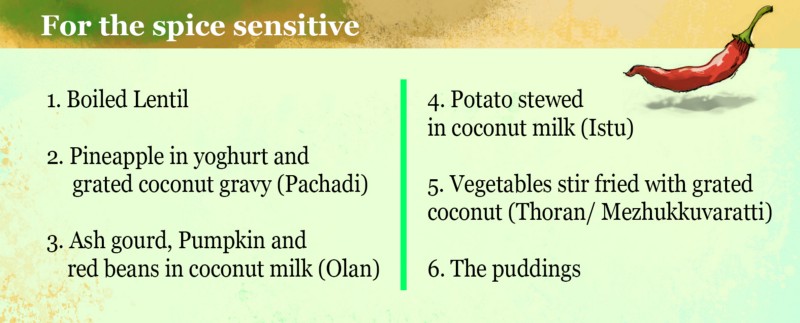
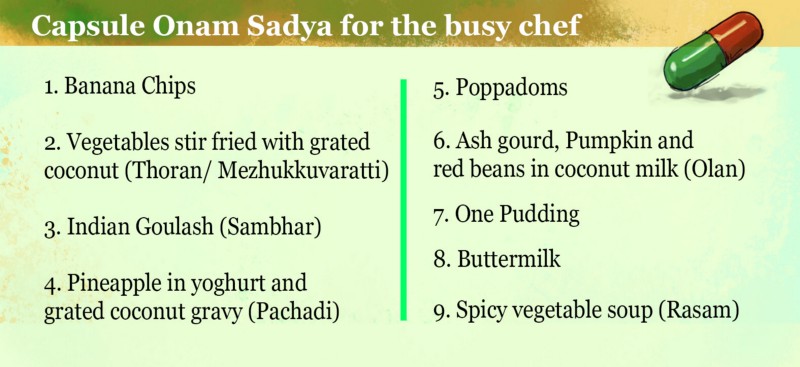
At the end of the meal, the right corner of the leaf is slit upward to signify that the leaf has already been used. Apparently people polished all this off so spotlessly that often it was hard to make out if the leaf was used or not! And turning it toward oneself is a subtle message to the chef, that there is room for improvement and folding it away from yourself, obviously means complete and utter satisfaction.
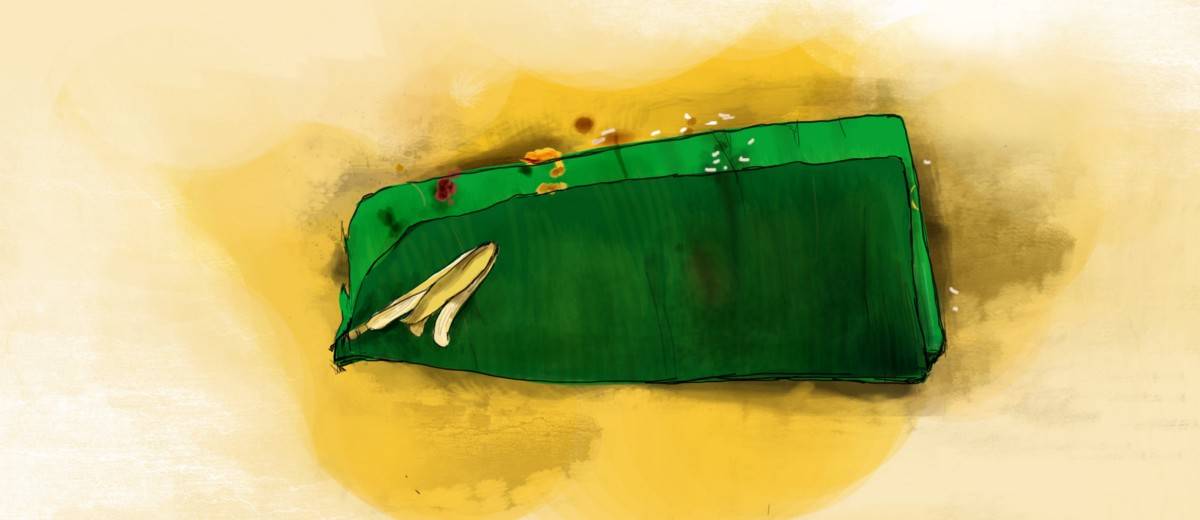
An interesting tidbit here, is that traditionally, the feast is made by brahmin men, through the night, so that the entire meal is ready before 10 AM. Apparently this was to ensure that the meal was ready before the pooja in the nearby temple called the ‘Athazha Pooja’ which quite literally translates into food pooja. Thank the lords for their discerning palettes!
Afraid of the Overload?… Think again
 urely the thought that all this seems a bit much for one little stomach, must have entered your minds at some stage. But guess what, the creators of this meal, had also kept in mind the digestive abilities of that organ. Also each of the said dishes are only consumed in small portions, so that all the unique flavours can be enjoyed, while leaving the stomach a happy customer.
urely the thought that all this seems a bit much for one little stomach, must have entered your minds at some stage. But guess what, the creators of this meal, had also kept in mind the digestive abilities of that organ. Also each of the said dishes are only consumed in small portions, so that all the unique flavours can be enjoyed, while leaving the stomach a happy customer.
There is a lot of use of Jeera or cumin which is an acid neutraliser, so there will be none of those nasty burps after a hearty meal. And the water that is consumed is also boiled with Jeera to further aid the digestion process. The yam that’s used in the Kaalan is so effective in clearing out the stomach, that in days of yore, households prepared something dishy with this root veggie at least once a week, just to get the stomach all spick and span. The benefits of the pineapple have been extolled earlier (ladies, I kid u not, its like a magic potion).
And its not just the digestive tract that’s looked after, this meal takes oral hygienic quite seriously too.The food is cooked in pure coconut oil, which is now being universally touted as the best thing for teeth and gums and such. And the cooking, if done right, involves absolutely no onions or garlic, thereby reducing the possibility of the absolute turnoff of smelly breath. Also, the paan with the betel leaves and arecanut combination is perfect for cleansing the palette and also serves as mouth freshener.
So all in all, one can safely say that the Onam Sadya was way ahead of its times, integrating taste, health, wealth and happiness all into one massive feast, dripping with fun, flavour and festivity.
Pretty much every vegetarian bemoaning the lack of any variety in their soup and salad laden lives, will crave this beyond anything else. The mystique surrounding India and its curries will always endure, and in the Sadya we have managed to also redefine the concept of a banquet. Once you have revelled in the visual and sensory largesse of the Sadya, a Sunday roast may just leave you pining for a bit more. And at the end of my own journey towards discovering the Sadya, I can most definitely say it occupies a sacred space in the world of culinary possibilities.
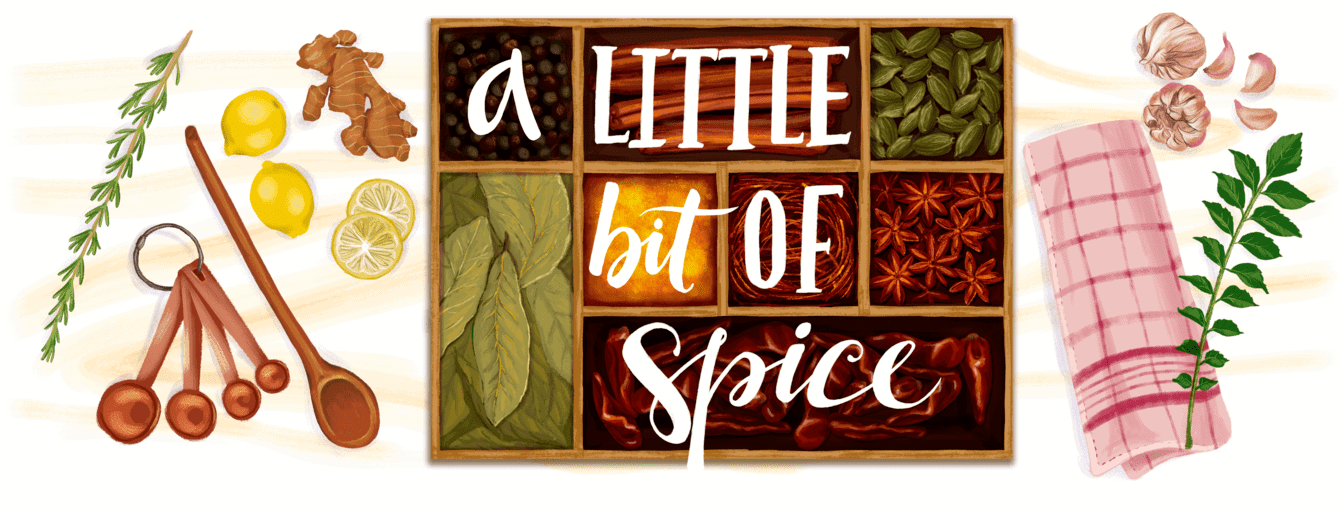




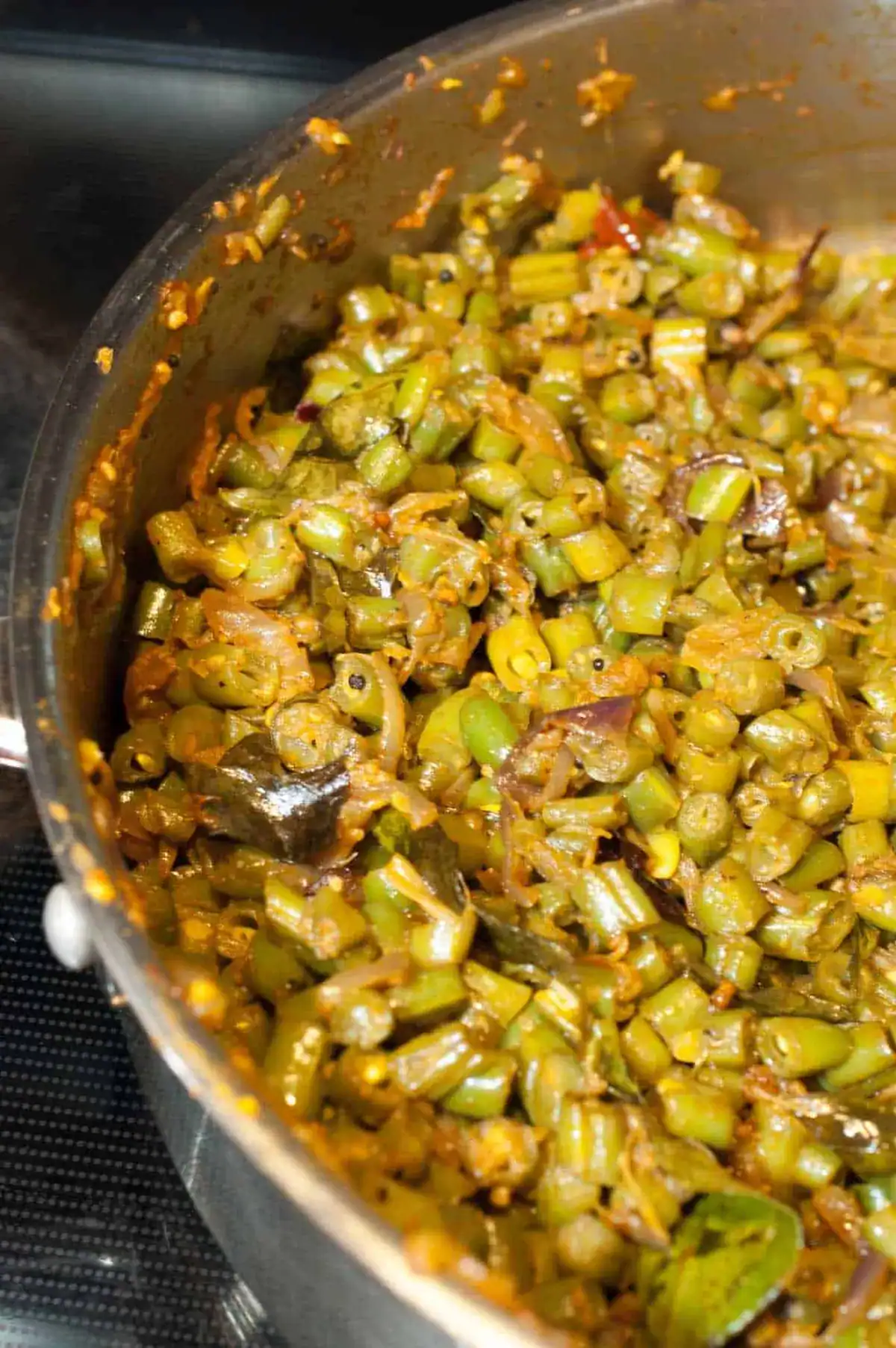
Start the discussion at comments.alittlebitofspice.com